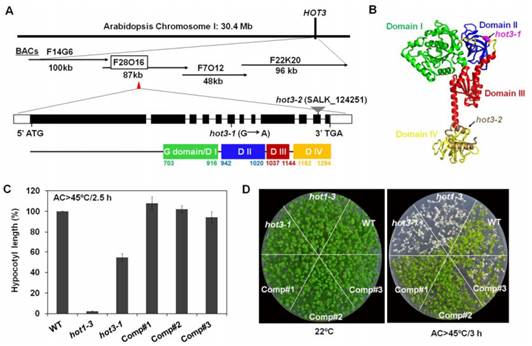

文章通讯作者麻省大学分子生物学家Elizabeth Vierling指出,随着全球气候变暖,高温对植物的破坏显著增加,耐热性机制的揭示不仅是一项基础研究,而且可能是未来人们用来提高植物在高温下生存能力的重要手段。
她说:“植物不仅需要生产新蛋白来抵御应激,还需要尽可能快地制造它们,我们发现新蛋白翻译被延迟6小时后,将会抑制最适生长和繁殖能力,虽然这些植物不会完全死亡,但蛋白质合成延迟它们就会受损。”
全套的新蛋白可为植物提供抵抗应激的能力。
Vierling和她在中国农业大学的同事们利用新一代测序和生化手段检测了野生型和失去高温生存能力的突变型拟南芥的蛋白质翻译和基因表达变化。
他们发现引起拟南芥表型变化的基因是一个“翻译因子”,该基因编码的蛋白质是一个已知的翻译起始因子eIF5B。
这篇文章发现了eIF5B的一个新角色。正如他们在文中写道:“通过比对拟南芥的温度敏感等位基因eIF5B(hot3-1),我们发现在热应激条件下,及时恢复翻译是植物从应激中恢复的关键。此外,在最适生长温度下一个更严重的等位基因(hot3-2)的翻译图谱(translational profiling)显示eIF5B1是植物正常生长发育的必须基因,进一步表明eIF5B1可差异化地影响特定mRNAs。”(来源:生物通)
Mutations in eIF5B confer thermosensitive and pleiotropic phenotypes via translation defects in Arabidopsis thaliana
Abstract The conserved eukaryotic translation initiation factor 5B, eIF5B, is a GTPase that acts late in translation initiation. We found that an Arabidopsis thaliana mutant sensitive to hot temperatures 3 (hot3-1), which behaves as wild type in the absence of stress but is unable to acclimate to high temperature, carries a missense mutation in eIF5B1 gene (At1g76810),, producing a temperature sensitive protein. A more severe, T-DNA insertion allele (hot3-2) causes pleiotropic developmental phenotypes. Surprisingly, Arabidopsis has three other eIF5B genes that do not substitute for eIF5B1; two of these appear to be in the process of pseudogenization. Polysome profiling and RNA-seq analysis of hot3-1 plants show delayed recovery of polysomes after heat stress and reduced translational efficiency (TE) of a subset of stress protective proteins, demonstrating the critical role of translational control early in heat acclimation. Plants carrying the severe hot3-2 allele show decreased TE of auxin-regulated, ribosome-related and electron transport genes, even under optimal growth conditions. The hot3-2 data suggest that disrupting specific eIF5B interactions on the ribosome can, directly or indirectly, differentially affect translation. Thus, modulating eIF5B interactions could be another mechanism of gene-specific translational control.
原文链接:http://www.plantcell.org/content/plantcell/early/2017/08/14/tpc.16.00808.full.pdf



